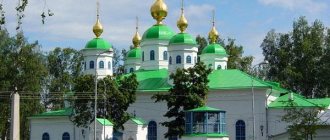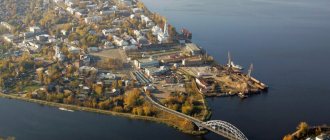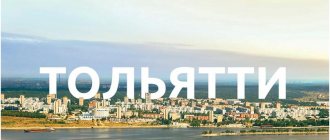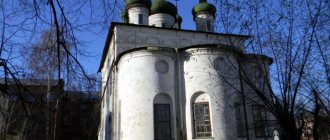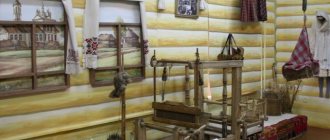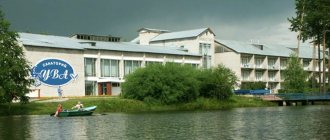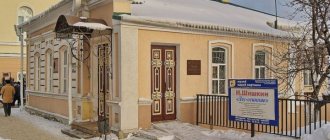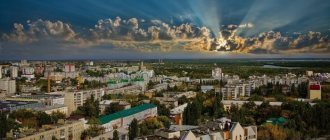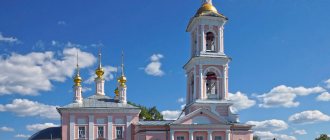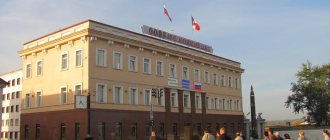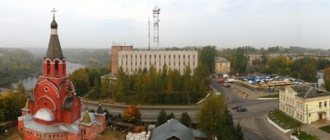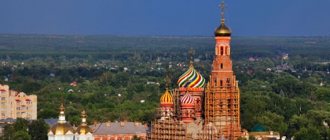Cherepovets is the largest city in the Vologda region with a variety of attractions. Cherepovets was first mentioned in the chronicle of 1362. The founding date of Cherepovets is considered to be June 4, 1777.
For 2017-2018, the population of Cherepovets was 318,856 people.
The origin of the name “Cherepovets” is not known for certain - there are numerous versions. In the 15th century this city was called “Cherepoves”. In short, the name consists of two parts - the Finno-Ugric “skull” - this is what they called the hill, the upper part of something, and the Finnish “whole” - water.
For the time being, the city was lucky: neither the Polish-Swedish intervention nor the First World War reached it. But already the Civil War of 1918-1921 and subsequent anti-religious events led to the closure of all religious buildings in the city.
In 1941, Cherepovets became a port - at that time the Rybinsk Reservoir appeared. During the Great Patriotic War, the city received evacuated residents of Leningrad. In the post-war years it became an industrial city. With the growth of industry, the population increased. Today more than 300 thousand people live in the city.
There are four districts in the city: Industrial (also called City), Zarechny, Zasheksninsky, Severny (also known as Plywood).
What is Cherepovets famous for?
Many people ask: what is this area famous for?
This city is the birthplace of the famous artist Vasily Vasilyevich Vereshchagin. Artist Vasily Vasilyevich Vereshchagin (October 14 (26), 1842 - March 31 (April 13), 1904)
This man created many battle paintings in a documentary style - for he himself participated in the battles. Not far from the Resurrection Cathedral, a monument was erected to the founders of Cherepovets - the monks Theodosius and Athanasius.
Fans of ancient cities will be interested in an article about the sights of Pskov.
The main attractions of Cherepovets
There are plenty of attractions in Cherepovets - which one is more interesting, where a tourist should go first - it’s up to you to decide. Photos of the city are the living history of Russia, because people lived here who left us a rich cultural and spiritual heritage.
Resurrection Cathedral
The date of construction is the 14th century, the place is where the Yagorba River flows into Sheksna. Until 1752, the church was wooden; later a stone structure appeared in its place. In 1852 the roof of the cathedral was replaced.
After the October Revolution, mass closures of churches began, and the Resurrection Monastery did not escape this fate. Of the entire complex, only the Resurrection Cathedral was able to be restored in the 1990s.
It is worth noting: work on the restoration of the temple continues to this day.
Cathedral address: Sovetsky Prospekt, building 1.
Church of the Nativity
The church was built at the end of the 15th century at the crossing of the Sheksna River. The wooden structure could only stand for two centuries, then collapsed. A stone structure was erected on the site of the collapsed structure, and in 1789 the church was consecrated.
In 1931, the church was abolished, the building was used for economic needs. In 1989, fire destroyed the structure. After the collapse of the USSR, the revival of the temple began. Construction was successfully completed in 1997.
Please note: the external appearance of the building is the same as in the pre-revolutionary years.
Temple address: Parkovaya street, building 1.
Vereshchagin House-Museum
As we mentioned above, Cherepovets is the birthplace of battle painter V.V. Vereshchagin. The artist drew well since childhood; perhaps his childhood pencil drawings also depict pictures of his native Cherepovets. Vasily Vasilyevich studied at a military school, participated in a number of battles and created paintings of different genres. Vereshchagin’s most famous painting is “The Doors of Tamerlane,” which sends us back to a distant era when Central Asia was ruled by the powerful ruler Timur-Tamerlane.
Vereshchagin took part in the Russian-Turkish War of 1877-1878, as well as in the Russian-Japanese War. April 13, 1904 was a truly dark day: the warship Petropavlovsk hit a mine and sank, and among the dead was V.V. Vereshchagin.
Since 1984, the house where the famous artist was born and other buildings of the Vereshchagin estate have become a museum complex. The address of the house-museum is Sotsialisticheskaya Street, building 22.
House-Museum of Milyutin
Ivan Andreevich Milyutin ruled the city of Cherepovets for a little less than half a century (from 1861 to 1907). The mayor is mentioned in one of the so-called “military aphorisms” of Kozma Prutkov (“it’s good to fish where the water flow is cloudy - long live Cherkessky and Milyutin!”).
House-Museum of I.A. Milyutin was opened in 2006. Address: Revolution Square, building 1.
Literary Museum of Igor Severyanin
Igor Severyanin is one of the most mysterious poets in Russia. The author of light, “airy” poetry, a classic romantic, little known to Soviet readers. The reason is an emigrant. An atmosphere of scandals and legends has developed around Igor Vasilyevich Lotarev (Severyanin - literary pseudonym). Even today, some of the riddles that this mysterious eccentric asked us remain unanswered.
This is interesting: for a long time there was no museum dedicated to Igor Severyanin. Only in the 1990s did the Lotarev estate, where there was a collective farm sanatorium under Soviet rule, become a literary museum.
The outwardly nondescript house has a unique furnishings - a mixture of pre-revolutionary and Soviet styles.
The address of the museum is the village of Vladimirovka, Severyanina Street, building 1.
Museum of the Metallurgical Industry
There is a museum dedicated to metallurgy in Cherepovets. Nostalgia awakens for Soviet times, when we were “...ahead of the rest.”
Visitors will get acquainted with the history of this industry and learn interesting facts about the Cherepovets Metallurgical Plant. Address: Mira street, house 42.
Museum of Nature
The history of this museum begins in the 1920s.
The building houses exhibitions dedicated to both the nature of the city and its surroundings, and long-extinct plants and animals. Address: Lunacharsky Avenue, building 32.
Monument to Saints Athanasius and Theodosius
In October 1992, when the anniversary of the birth of V.V. was celebrated. Vereshchagin, a monument to the founders of the city, Athanasius and Feodosius, appeared in Cherepovets.
Historical fact: Theodosius was once a merchant, but after the death of his family during a plague epidemic he became a monk. Monk Athanasius was a hermit, he was known by the nickname “Iron Staff”.
The monument was erected near the Resurrection Cathedral.
Oktyabrsky Bridge
The construction of the bridge across the Sheksna River began on the day when the centenary of the birth of V.I. Lenin. Nine years later, vehicles began to travel across the Oktyabrsky Bridge.
Please note: this was the first cable-stayed bridge in Russia (then the RSFSR). Moreover, the structure was very similar to the Cologne bridge over the Rhine.
Galisky Estate
Architectural landmark of the city. Unlike other Cherepovets estates, where most of the buildings were not preserved, the Galsky estate successfully survived the revolution and the Civil War.
All buildings of the landowner's estate have survived to this day.
Address: Maturinskaya street, building 28.
Art Museum
Opened under Soviet rule.
Among the exhibits are paintings, sculptures, and a collection of icons created from the 14th to the 19th centuries. The exhibition hall displays the works of contemporary masters. Address – Sovetsky Prospekt, building 30a.
Monument to metallurgists
Cherepovets is famous for its metallurgical plant.
In honor of the workers, a monument was erected on the city square in 2005, symbolizing the continuity of generations of metallurgists. To get to the attraction, you need to get to Metallurgists Square.
Chamber theater
The history of this building begins in the 1860s, when a troupe of amateur actors appeared. In 1938, a theater with a professional troupe opened, but it only worked until 1948.
It is July 1, 1993 that is considered to be the birthday of the Chamber Theater. After the revival, the theater received its own building. Address – Sovetsky Prospekt, building 35B.
House of Volkovs
This building was built at the beginning of the 19th century. The house was two-story, the first floor was dedicated to a wine store, and the second floor was residential.
The exact layout of the house is unknown - the papers with the plans were lost under Soviet rule.
Address: Sovetsky Prospekt, building 21.
Komsomolsky Park
The most famous vacation spot for locals. It received its name in honor of the Lenin Komsomol, whose members actively took part in the formation and development of the park.
This is interesting: previously, on the site of the park there was an old cemetery, where quite famous personalities were buried, for example, the former head of Cherepovets I.A. Milyutin.
Monuments of Cherepovets
Cherepovets is located on the territory of the Volgograd region, at the confluence of the Yagroba and Sheksna rivers. The city was founded in 1777 and is considered the most important transport and industrial center. It has a large population and an impressive area, which is not typical for most regional cities. However, Cherepovets is famous primarily for its rich and quite interesting history. It began back in 1362 with the construction of the Resurrection Monastery for men. Local people are extremely proud of their rich past, and this is reflected in the numerous monuments, war memorials and historical sites. There are sculptures dedicated to V.I. Lenin, V.V. Vereshchagin and G.K. Zhukov, as well as a bust of the famous Soviet poet N.M. Rubtsov. Decorating city streets is an extremely important matter, which is why it continues here to this day. Modern art objects and compositions appear, distinguished by their beauty and special historical significance. Walking around the city, you can admire the Cherepovets Globe or see the memorial dedicated to the liquidators of the Chernobyl disaster.
There is also a monument to Soviet metallurgists in the city, and it is called “Continuity of Generations”. The monument was erected in 2006 and dedicated to the 50th anniversary of the Cherepovets Metallurgical Plant. It is made of marble, and the local sculptor A. Shebunin worked on the project. The composition consists of a memorial stele, symbolizing a flame escaping from a steel-smelting furnace. To the right of the stele sits a stern worker and watches his young son. The composition symbolizes the continuity of generations and the importance of the Russian metallurgical industry.
Cherepovets also remembers the soldiers who died in battles with Nazi Germany. A memorial to military glory has been erected on the territory of the city military cemetery. It appeared here back in 1975 and dedicated to the 30th anniversary of the Great Victory. The composition consists of the figure of a Soviet soldier bowing before the Eternal Flame. Behind the soldier is a memorial plate with high relief and memorial text. The sculptor A.V. Shchepelkin and the capital’s architect V.E. Shalashov worked on the composition.
The monument to the nurse is also worthy of attention. The monument was founded in 2015 and is dedicated to the nurses who worked during the Second World War. The project was completed by the capital's architect A. Rozhnikov, on the initiative of grateful city residents. Visitors are presented with a composition made in an unusual three-dimensional style. Shown here is a nurse, dressed in a military uniform, holding the hand of a little girl. Behind them stood the wounded refugees, hoping for a quick rescue.
There are other iconic cultural attractions in the city. Arriving in Cherepovets, you can see the sculpture of Athanasius and Theodosius, stand at the military obelisk “Bayonets” or admire the memorial sign created in honor of the founding of the city.
Interesting sights of Cherepovets - photos and descriptions
On our website you will find beautiful photos of the sights of Cherepovets and their descriptions.
Art gallery E.M. Lunina
The gallery was opened in 2001, with works displayed for viewing, but not for sale. Among the works are examples of brushes by graphic artists and painters (both famous and little-known artists), as well as sculptures. Address: Yubileinaya street, building 36.
Museum of History and Local Lore
The building was built in 1928. The museum constantly has an exhibition dedicated to the history of Cherepovets - a city as young as it is ancient.
Visitors will learn about how the soldiers of the Golden Horde dressed, what the first blast furnace was like, what living rooms looked like in the 1930s and 1950s, and so on. Address – Sovetsky Prospekt, building 30A.
Museum of Archeology
The museum was built in the 1870s.
Today there are more than 100 thousand exhibits here. Their age varies widely: from the times when mammoths still walked the earth to the 14th century. Address: Krasnaya street, building 1v.
Monument to Nikolai Rubtsov
Nikolai Mikhailovich Rubtsov is a famous Soviet lyric poet. The poet's fate was tragic: in mid-January 1971, Rubtsov died at the hands of his beloved, poetess L. Derbina (the most interesting thing is that the poet foresaw his death by writing the poem “I will die in the Epiphany frosts”).
In 1998, a monument-bust of Rubtsov was erected in Cherepovets.
Take note: in 1999, a tradition appeared on the poet’s birthday, January 3, to read his poems and discuss interesting facts related to the work of N.M. Rubtsova.
Temples you must visit
Cherepovets is famous for several churches that have survived over the centuries. The city is visited by pilgrims, believers, and tourists. They are interested in the venerable monuments of the Orthodox Church. By visiting local shrines, people find peace of mind and feel God’s mercy upon them.
Church of the Nativity
At the origins of the temple, a wooden structure dedicated to St. Nicholas the Wonderworker is mentioned. The saint is known as the patron saint of travelers and sailors.
In the 16th century, instead of a wooden building, the Church of the Nativity of Christ was erected. By the end of the 1980s, the cathedral, like many other churches, was desolate.
The Cherepovets Museum provided historical and architectural materials, on the basis of which the church restoration project was carried out. It was practically rebuilt. Construction and renovation work took 6 years.
The renovated cathedral was consecrated in 1997. The single-domed snow-white building has become a radiant and memorable decoration of Cherepovets.
The architectural complex consists of an upper and lower temple. In the lower one, ceremonial baptismal ceremonies are held. There is an original marble baptistery there. The temple preserves valuable icons. Reliquaries contain particles of saints and great martyrs.
In 2005, a donated capsule containing a particle from the Life-Giving Cross of the Lord was brought from Jerusalem. They placed this gift in the Crucifixion.
Temple bells were made in Voronezh. Their ringing can be heard far beyond the city limits.
On Wednesdays, during the evening service, an akathist to St. Nicholas is performed. Every Saturday, before the icon of the Mother of God called “The Inexhaustible Chalice,” a prayer service with an akathist is served.
The Church of the Nativity is the first to greet guests who arrive in the city by river. The bell tower topped with a spire is visible from afar. Strict classical forms give the temple a resemblance to a ship. The red copper-clad domes are akin to symbols of warmth and shelter.
The temple is located on the street. Parkovaya, 1.
Resurrection Cathedral
In the 14th century, monks of the Trinity-Sergius Lavra founded the Resurrection Monastery. According to an established tradition, temples were built in monasteries. In 1752 - 1756, a stone Resurrection Cathedral was erected in the monastery. Cherepovets received the core, which became the beginning of the city.
The cathedral is a 4-pillar building, rectangular in plan. The building is crowned with 5 domes. They have the shape of 8-sided shapes. The bulbs are covered with gold. External decorativeness indicates the features of the Moscow architectural style.
The main entrance is decorated with a mosaic face of Christ. The altar (place for prayer) is the most ancient part of the cathedral. Among the temple treasures are reliquaries with the remains of John the Baptist, Alexander of Svir, Great Martyr Barbara, John the Warrior and other saints.
The Church of the Resurrection of Christ is located on Cathedral Hill. The building rises near the confluence of the Yagorba River and the Sheksna. This is the center of old Cherepovets.
The current address of the cathedral: Sovetsky Prospekt, 1.
Church of St. Nicholas the Wonderworker
In 1904, a chapel in the name of St. Nicholas was built on the station platform. Now a small altar has been installed inside the building, like in a temple. This allows for regular worship services.
St. Nicholas Chapel is distinguished by its distinctive Russian style. Intricate decor adorns the facades. A variety of profile bricks were used in the construction. The white and turquoise color gives it a special tenderness.
The chapel became a small temple decorating the entire station complex. The architecture of the chapel is extremely elegant.
In 2016, a particle of the relics of St. Nicholas was transferred to the chapel. This happened during Lent. Since that time, the shrine has been open for worship. Anyone can venerate the relics at a time convenient for them (08.00 – 20.00).
Before the relics, every Wednesday evening, an akathist to the Saint is read. A prayer service is ordered in the chapel for increased love and a safe journey. They also turn to the saint with other requests.
Orthodox shrines of Cherepovets
The city has small temples-chapels, as well as temples and cathedrals. One of the buildings worth seeing is dedicated to the founders of Cherepovets.
Chapel of the Icon of the Mother of God Life-Giving Spring
The history of this building is not very ancient, but eventful. At first the chapel was wooden, then a stone building was erected in its place. After the Civil War, the former chapel was adapted for household needs, and the source was blocked.
Only in 2000 did the restoration of the building begin. In 2014, the Divine Liturgy was held there, and the chapel became a temple dedicated to the icon of the Blessed Virgin Mary.
To get to the building, you need to get to Lenin Street and find house 1a.
Temple of Saints Athanasius and Theodosius of Cherepovets
This religious building was erected relatively recently, in 2012.
The cathedral was named in honor of the founders of the city of Cherepovets. Address: Makarinskaya Grove, building 1.
St. Nicholas Chapel
The building was built in 1904; 20 years later the chapel was closed. After the collapse of the USSR, this small church was opened again.
The shape of the building is cubic, the style of construction is false Russian. The chapel is located near the Cherepovets railway station.
Chapel of St. Philip of Irapa
This building was built in the 1870s at the expense of the abbots of the Filippo-Irap desert. The chapel was closed under Soviet rule.
In post-Soviet times, the building was restored, and the interior was updated. In 2000, the relics of St. Philip of Irapa were found.
Attraction address: Sovetsky Prospekt, 31.
List of Orthodox churches in the city of Cherepovets
The expanses of the Vologda region are dotted with many Orthodox churches. Several striking cathedrals are located in Cherepovets.
The list of Cherepovets churches includes the Resurrection and Annunciation Cathedrals. Many churches are also famous:
- Trinity;
- John the Evangelist;
- Pokrovskaya (at the Korzhakovsky cemetery);
- Presentation of the Lord;
- Nicholas the Wonderworker;
- Alexander Nevsky;
- Prison;
- Nativity of Christ;
- Joachim and Anna;
- Athanasius and Theodosius.
Cherepovets - attractions for children
The city has two cultural centers for children: a museum and a musical theater.
Children's Museum
In 1988, an unusual museum appeared in Cherepovets, designed for a children's audience. Since 2001, it has been housed in a two-story stone house.
Among the exhibits are children's shoes and clothing, collections of toys made from different materials (classic soft toys, as well as clay and wood). Address: Lunacharsky Avenue, building 39.
Children's musical theater
In May 1991, a musical theater for children opened in Cherepovets. Its auditorium is small, the so-called “home” format.
Performances are organized for young spectators, shadow theater fairy tales are acted out, and works of children's writers are recited. Children are also introduced to musical instruments. Address: Stroiteley Square, building 1.
